Ying Ma
RTV-Bench: Benchmarking MLLM Continuous Perception, Understanding and Reasoning through Real-Time Video
May 04, 2025Abstract:Multimodal Large Language Models (MLLMs) increasingly excel at perception, understanding, and reasoning. However, current benchmarks inadequately evaluate their ability to perform these tasks continuously in dynamic, real-world environments. To bridge this gap, we introduce RTV-Bench, a fine-grained benchmark for MLLM real-time video analysis. RTV-Bench uses three key principles: (1) Multi-Timestamp Question Answering (MTQA), where answers evolve with scene changes; (2) Hierarchical Question Structure, combining basic and advanced queries; and (3) Multi-dimensional Evaluation, assessing the ability of continuous perception, understanding, and reasoning. RTV-Bench contains 552 diverse videos (167.2 hours) and 4,631 high-quality QA pairs. We evaluated leading MLLMs, including proprietary (GPT-4o, Gemini 2.0), open-source offline (Qwen2.5-VL, VideoLLaMA3), and open-source real-time (VITA-1.5, InternLM-XComposer2.5-OmniLive) models. Experiment results show open-source real-time models largely outperform offline ones but still trail top proprietary models. Our analysis also reveals that larger model size or higher frame sampling rates do not significantly boost RTV-Bench performance, sometimes causing slight decreases. This underscores the need for better model architectures optimized for video stream processing and long sequences to advance real-time video analysis with MLLMs. Our benchmark toolkit is available at: https://github.com/LJungang/RTV-Bench.
Temporal Causal Discovery in Dynamic Bayesian Networks Using Federated Learning
Dec 13, 2024



Abstract:Traditionally, learning the structure of a Dynamic Bayesian Network has been centralized, with all data pooled in one location. However, in real-world scenarios, data are often dispersed among multiple parties (e.g., companies, devices) that aim to collaboratively learn a Dynamic Bayesian Network while preserving their data privacy and security. In this study, we introduce a federated learning approach for estimating the structure of a Dynamic Bayesian Network from data distributed horizontally across different parties. We propose a distributed structure learning method that leverages continuous optimization so that only model parameters are exchanged during optimization. Experimental results on synthetic and real datasets reveal that our method outperforms other state-of-the-art techniques, particularly when there are many clients with limited individual sample sizes.
Enabling On-Device LLMs Personalization with Smartphone Sensing
Jul 05, 2024

Abstract:This demo presents a novel end-to-end framework that combines on-device large language models (LLMs) with smartphone sensing technologies to achieve context-aware and personalized services. The framework addresses critical limitations of current personalization solutions via cloud-based LLMs, such as privacy concerns, latency and cost, and limited personal sensor data. To achieve this, we innovatively proposed deploying LLMs on smartphones with multimodal sensor data and customized prompt engineering, ensuring privacy and enhancing personalization performance through context-aware sensing. A case study involving a university student demonstrated the proposed framework's capability to provide tailored recommendations. In addition, we show that the proposed framework achieves the best trade-off in privacy, performance, latency, cost, battery and energy consumption between on-device and cloud LLMs. Future work aims to integrate more diverse sensor data and conduct large-scale user studies to further refine the personalization. We envision the proposed framework could significantly improve user experiences in various domains such as healthcare, productivity, and entertainment by providing secure, context-aware, and efficient interactions directly on users' devices.
Knowledge Graph Reasoning with Self-supervised Reinforcement Learning
May 22, 2024



Abstract:Reinforcement learning (RL) is an effective method of finding reasoning pathways in incomplete knowledge graphs (KGs). To overcome the challenges of a large action space, a self-supervised pre-training method is proposed to warm up the policy network before the RL training stage. To alleviate the distributional mismatch issue in general self-supervised RL (SSRL), in our supervised learning (SL) stage, the agent selects actions based on the policy network and learns from generated labels; this self-generation of labels is the intuition behind the name self-supervised. With this training framework, the information density of our SL objective is increased and the agent is prevented from getting stuck with the early rewarded paths. Our self-supervised RL (SSRL) method improves the performance of RL by pairing it with the wide coverage achieved by SL during pretraining, since the breadth of the SL objective makes it infeasible to train an agent with that alone. We show that our SSRL model meets or exceeds current state-of-the-art results on all Hits@k and mean reciprocal rank (MRR) metrics on four large benchmark KG datasets. This SSRL method can be used as a plug-in for any RL architecture for a KGR task. We adopt two RL architectures, i.e., MINERVA and MultiHopKG as our baseline RL models and experimentally show that our SSRL model consistently outperforms both baselines on all of these four KG reasoning tasks. Full code for the paper available at https://github.com/owenonline/Knowledge-Graph-Reasoning-with-Self-supervised-Reinforcement-Learning.
Diverse Motion In-betweening with Dual Posture Stitching
Mar 25, 2023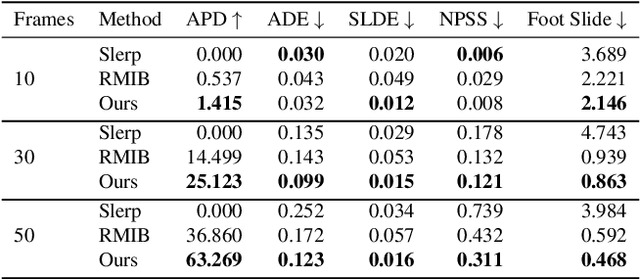

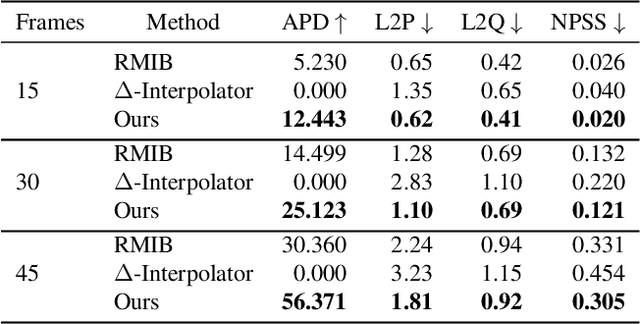
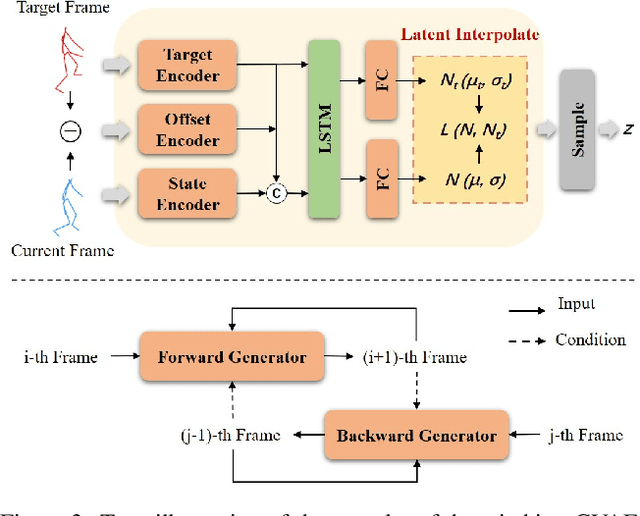
Abstract:In-betweening is a technique for generating transitions given initial and target character states. The majority of existing works require multiple (often $>$10) frames as input, which are not always accessible. Our work deals with a focused yet challenging problem: to generate the transition when given exactly two frames (only the first and last). To cope with this challenging scenario, we implement our bi-directional scheme which generates forward and backward transitions from the start and end frames with two adversarial autoregressive networks, and stitches them in the middle of the transition where there is no strict ground truth. The autoregressive networks based on conditional variational autoencoders (CVAE) are optimized by searching for a pair of optimal latent codes that minimize a novel stitching loss between their outputs. Results show that our method achieves higher motion quality and more diverse results than existing methods on both the LaFAN1 and Human3.6m datasets.
Lattice-based Improvements for Voice Triggering Using Graph Neural Networks
Jan 25, 2020



Abstract:Voice-triggered smart assistants often rely on detection of a trigger-phrase before they start listening for the user request. Mitigation of false triggers is an important aspect of building a privacy-centric non-intrusive smart assistant. In this paper, we address the task of false trigger mitigation (FTM) using a novel approach based on analyzing automatic speech recognition (ASR) lattices using graph neural networks (GNN). The proposed approach uses the fact that decoding lattice of a falsely triggered audio exhibits uncertainties in terms of many alternative paths and unexpected words on the lattice arcs as compared to the lattice of a correctly triggered audio. A pure trigger-phrase detector model doesn't fully utilize the intent of the user speech whereas by using the complete decoding lattice of user audio, we can effectively mitigate speech not intended for the smart assistant. We deploy two variants of GNNs in this paper based on 1) graph convolution layers and 2) self-attention mechanism respectively. Our experiments demonstrate that GNNs are highly accurate in FTM task by mitigating ~87% of false triggers at 99% true positive rate (TPR). Furthermore, the proposed models are fast to train and efficient in parameter requirements.
Penalized matrix decomposition for denoising, compression, and improved demixing of functional imaging data
Jul 17, 2018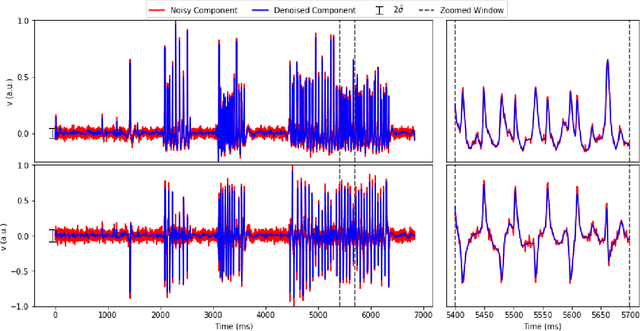
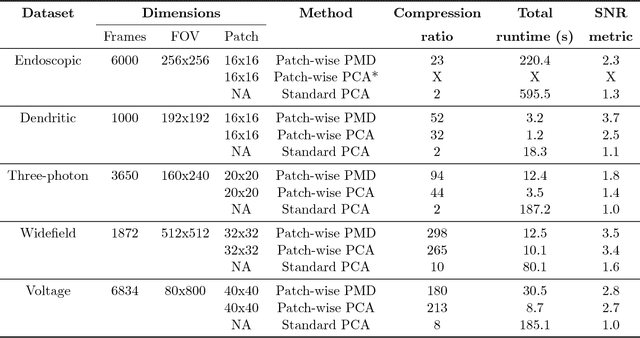
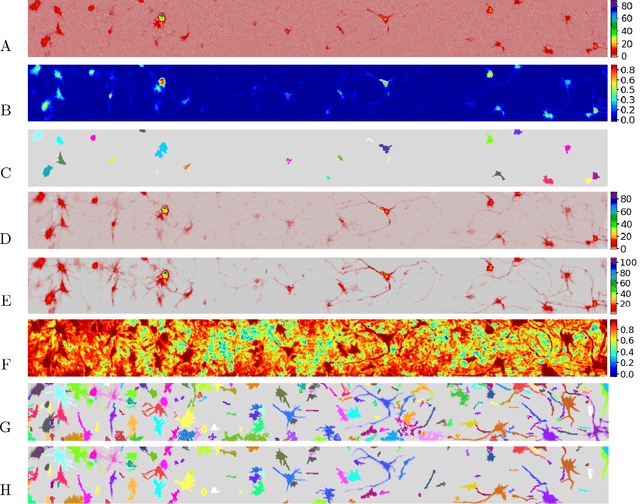
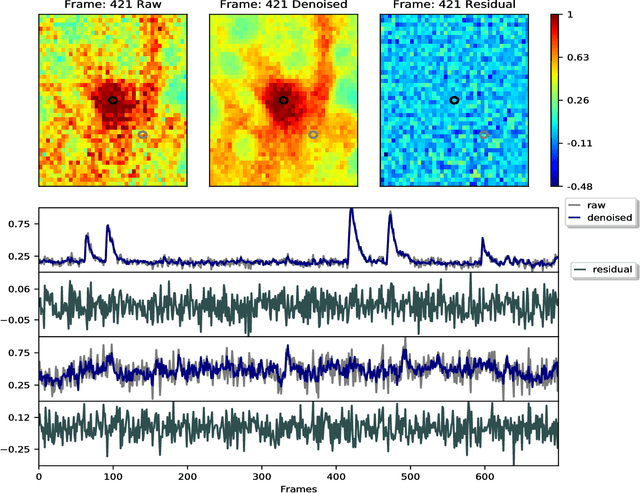
Abstract:Calcium imaging has revolutionized systems neuroscience, providing the ability to image large neural populations with single-cell resolution. The resulting datasets are quite large, which has presented a barrier to routine open sharing of this data, slowing progress in reproducible research. State of the art methods for analyzing this data are based on non-negative matrix factorization (NMF); these approaches solve a non-convex optimization problem, and are effective when good initializations are available, but can break down in low-SNR settings where common initialization approaches fail. Here we introduce an approach to compressing and denoising functional imaging data. The method is based on a spatially-localized penalized matrix decomposition (PMD) of the data to separate (low-dimensional) signal from (temporally-uncorrelated) noise. This approach can be applied in parallel on local spatial patches and is therefore highly scalable, does not impose non-negativity constraints or require stringent identifiability assumptions (leading to significantly more robust results compared to NMF), and estimates all parameters directly from the data, so no hand-tuning is required. We have applied the method to a wide range of functional imaging data (including one-photon, two-photon, three-photon, widefield, somatic, axonal, dendritic, calcium, and voltage imaging datasets): in all cases, we observe ~2-4x increases in SNR and compression rates of 20-300x with minimal visible loss of signal, with no adjustment of hyperparameters; this in turn facilitates the process of demixing the observed activity into contributions from individual neurons. We focus on two challenging applications: dendritic calcium imaging data and voltage imaging data in the context of optogenetic stimulation. In both cases, we show that our new approach leads to faster and much more robust extraction of activity from the data.
A Taxonomy for Neural Memory Networks
May 01, 2018



Abstract:In this paper, a taxonomy for memory networks is proposed based on their memory organization. The taxonomy includes all the popular memory networks: vanilla recurrent neural network (RNN), long short term memory (LSTM ), neural stack and neural Turing machine and their variants. The taxonomy puts all these networks under a single umbrella and shows their relative expressive power , i.e. vanilla RNN <=LSTM<=neural stack<=neural RAM. The differences and commonality between these networks are analyzed. These differences are also connected to the requirements of different tasks which can give the user instructions of how to choose or design an appropriate memory network for a specific task. As a conceptual simplified class of problems, four tasks of synthetic symbol sequences: counting, counting with interference, reversing and repeat counting are developed and tested to verify our arguments. And we use two natural language processing problems to discuss how this taxonomy helps choosing the appropriate neural memory networks for real world problem.
 Add to Chrome
Add to Chrome Add to Firefox
Add to Firefox Add to Edge
Add to Edge